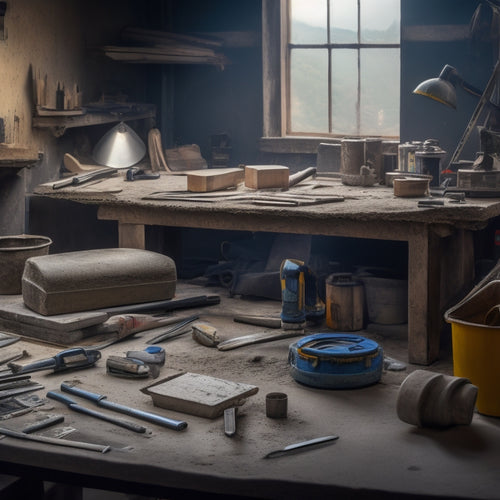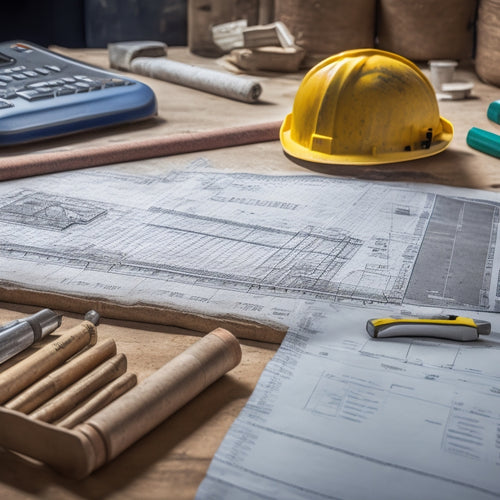
7 Essential Epoxy Concrete Crack Repair Tools
Share
You'll need a solid arsenal of epoxy concrete crack repair tools to tackle projects efficiently and effectively. Start by selecting the right crack injection gun, matching it to your injection technique and epoxy delivery system. Next, prepare your epoxy resin with accurate measurements and mixing techniques. Properly clean and prepare the concrete surface using specialized tools, and measure crack widths with precision devices like crack width gauges or digital calipers. Don't forget essential safety gear, epoxy injection nozzles, and cleaning and debonding tools. With these 7 essential tools, you'll be well-equipped to achieve successful, long-lasting repairs - and by exploring each tool in more detail, you'll reveal the full potential of your epoxy concrete crack repair projects.
Key Takeaways
• Selecting the right crack injection gun is crucial, considering factors like injection technique, epoxy delivery system, and resin viscosity.
• Epoxy resin mixing requires accurate measurement of resin-to-hardener ratio, proper mixing technique, and thorough consistency for a strong bond.
• Surface preparation involves removing old adhesive residue, cleaning cracked areas, and grinding surfaces smooth for proper epoxy adhesion.
• Accurate measurement of crack width is critical, using tools like crack width gauges, digital calipers, or optical comparators to ensure effective repair.
• Safety equipment, including gloves, safety goggles, respirators, protective clothing, and non-slip shoes, is essential for epoxy handling and application.
Crack Injection Gun Selection
You'll need to select the right crack injection gun for your epoxy concrete crack repair project, as it's an important component that determines the efficiency and effectiveness of the repair process. The crack injection gun is responsible for delivering epoxy resin into the crack, and its performance directly impacts the quality of the repair.
When choosing a crack injection gun, consider the type of crack injection techniques you'll be using. Will you be using low-pressure or high-pressure injection methods? Different guns are designed for specific techniques, so it's vital to select one that matches your needs.
Look for a gun that's compatible with your epoxy delivery systems. Confirm the gun can handle the viscosity and flow rate of your epoxy resin. A gun with adjustable pressure and flow control will give you more flexibility and precision.
Additionally, consider the gun's durability, ease of use, and maintenance requirements. A high-quality crack injection gun will help you achieve a successful repair, so take the time to select the right one for your project. By doing so, you'll be able to efficiently and effectively repair cracks in your concrete structure.
Epoxy Resin Mixing Essentials
When you're preparing to mix epoxy resin for concrete crack repair, you'll need to get the ratio of resin to hardener just right.
You'll also need to decide on a mixing technique that suits your specific project requirements.
Resin Ratio Matters
Resin Ratio Matters
Accurate measurement of the epoxy resin and hardener is essential, as the ideal resin ratio can make or break the success of your concrete crack repair project. You need to guarantee you're using the correct ratio to achieve the desired properties, such as strength, flexibility, and curing time.
| Resin Type | Resin-to-Hardener Ratio |
|---|---|
| General-purpose epoxy | 2:1 or 3:1 |
| High-strength epoxy | 1:1 or 1.5:1 |
| Flexible epoxy | 4:1 or 5:1 |
| Fast-curing epoxy | 1:1 or 1.2:1 |
| Slow-curing epoxy | 2:1 or 2.5:1 |
The ratio affects the curing time, with faster-curing epoxies typically having a 1:1 ratio. You'll want to choose a resin type that suits your project's specific needs, considering factors like temperature, humidity, and desired finish. Remember, an incorrect ratio can lead to a weak or brittle bond, compromising the integrity of your repair. Take the time to get it right, and you'll be rewarded with a strong, long-lasting fix.
Mixing Techniques Vary
Accurate measurement of the epoxy resin and hardener is only the first step, as proper mixing techniques are equally vital to achieving a strong and lasting bond.
You'll need to choose the right mixing method for your specific application, as different methods can affect the epoxy consistency. For example, mechanical mixing with a drill and mixing paddle can introduce air into the mixture, which can lead to a weaker bond. On the other hand, manual mixing with a stick or paddle can be more effective for small batches, but may not be as efficient for larger quantities.
Regardless of the mixing method you choose, it's essential to mix thoroughly and consistently. Start by mixing the resin and hardener separately, then combine them and mix until you achieve a uniform color and consistency. Scrape the sides and bottom of the mixing container to guarantee all material is well incorporated.
Avoid overmixing, as this can generate heat and cause the epoxy to cure prematurely. By mastering the art of epoxy mixing, you'll be able to achieve a strong, durable bond that will last for years to come.
Concrete Surface Preparation Tools
When you're preparing a concrete surface for epoxy crack repair, you'll need to tackle three critical steps.
First, you'll remove any old adhesive or residue from the cracked area to guarantee a strong bond.
Next, you'll clean the cracked area to remove dirt and debris.
Remove Old Adhesive
You'll need to scrape off old adhesive residue from the concrete surface using specialized tools to guarantee a strong bond between the epoxy and the concrete. This vital step in concrete surface preparation makes certain the epoxy adheres properly, preventing future cracks and guaranteeing a long-lasting repair.
To remove old adhesive, you'll employ adhesive removal techniques such as mechanical scraping or chemical stripping. Mechanical scraping involves using tools like putty knives, chisels, or scrapers to physically remove the old adhesive. Chemical stripping, on the other hand, involves applying a solvent to break down the adhesive, making it easier to remove.
When choosing a surface preparation method, consider the type of adhesive, its age, and the condition of the concrete. Always follow the manufacturer's instructions for the removal tools and materials to avoid damaging the concrete surface.
Clean Cracked Area
With a clean slate achieved by removing old adhesive, your next step is to meticulously clean the cracked area using concrete surface preparation tools, such as wire brushes, brooms, or vacuum cleaners, to remove dirt, debris, and other contaminants that may interfere with the epoxy's adhesion. This essential step guarantees a strong bond between the epoxy and the concrete.
To effectively clean the cracked area, employ the following cleaning techniques:
-
Wire brushing: Use a wire brush to scrub away dirt, grime, and other surface contaminants that may be lodged in the crack.
-
Vacuuming: Utilize a vacuum cleaner to remove loose debris and dust from the cracked area, guaranteeing a clean surface for the epoxy application.
-
Damp mopping: Gently mop the area with a damp cloth to remove any remaining dirt or debris, taking care not to saturate the concrete.
Grind Surface Smooth
To achieve a smooth surface, prepare your concrete surface preparation tools, including angle grinders or concrete grinders, to grind away rough edges and irregularities that could compromise the epoxy's adhesion.
You'll want to focus on surface leveling, ensuring the area is even and flat. This step is vital, as any imperfections can lead to a weak bond between the concrete and epoxy.
As you grind, use a slow and controlled motion to avoid creating scratches or swirl marks. Change your grinding disk frequently to maintain a consistent finish.
For a smooth finish, switch to a finer grit disk (80-100) and work your way up to a higher grit (120-150) for a high-gloss finish. Use a dustless grinding system or vacuum to minimize dust and debris.
When you're satisfied with the surface, use a finishing technique like dry polishing or wet polishing to achieve the desired sheen.
Remember to inspect the surface for any remaining imperfections before applying the epoxy. A smooth, level surface is essential for a successful epoxy concrete crack repair.
Crack Width Measuring Devices
How accurately can you determine the width of a concrete crack, given its significance in selecting the right epoxy repair method?
Accurate crack width measurement is critical in crack assessment techniques, as it directly impacts the choice of repair method and material. Incorrect measurements can lead to inadequate repairs, further compromising the structure's integrity.
To guarantee precise measurements, you'll need the right tools. Here are three essential crack width measuring devices:
-
Crack width gauges: These simple, handheld tools provide a quick and easy way to measure crack widths. They typically consist of a series of graduated slots or notches that allow you to measure widths up to 1/4 inch.
-
Digital calipers: These versatile tools offer precise measurements with an accuracy of ±0.001 inches. They're ideal for measuring crack widths, as well as other dimensions, such as depth and length.
-
Optical comparators: These advanced tools use a microscope and a precision stage to measure crack widths with an accuracy of ±0.0001 inches. They're particularly useful for measuring very narrow cracks or those with complex geometries.
Epoxy Injection Nozzle Options
You'll need to select the right epoxy injection nozzle for your repair job, as it directly affects the success of the epoxy injection process. With various nozzle types and materials available, it's essential to choose the one that suits your specific needs.
Here's a breakdown of common epoxy injection nozzle options:
| Nozzle Type | Material | Application |
|---|---|---|
| Standard | Stainless Steel | General-purpose repairs |
| High-Pressure | Tungsten Carbide | Thick cracks or high-flow epoxy |
| Flexible | PVC or Silicone | Curved or hard-to-reach cracks |
| Multi-Port | Brass or Aluminum | Large, complex crack networks |
When selecting a nozzle, consider factors like crack width, epoxy viscosity, and injection pressure. For instance, stainless steel nozzles are suitable for general-purpose repairs, while tungsten carbide nozzles are ideal for high-pressure applications. Flexible nozzles, on the other hand, are perfect for curved or hard-to-reach cracks. By choosing the right nozzle, you'll guarantee a successful epoxy injection process and a durable, long-lasting repair.
Safety Gear for Epoxy Handling
Handling epoxy resins requires wearing proper safety gear to prevent skin irritation, respiratory issues, and other health hazards. You don't want to compromise your health while working on epoxy concrete crack repairs. As you prepare for the task, make certain you have the necessary personal protective equipment (PPE) to guarantee epoxy safety.
Here are the essential safety gear you should have:
-
Gloves: Nitrile or neoprene gloves will protect your hands from skin irritation and epoxy resin absorption. Look for gloves with a good grip to prevent slipping.
-
Safety Goggles: Epoxy resin can splatter or spill, so it's vital to wear safety goggles to protect your eyes from chemical exposure.
-
Respirator: When working with epoxy resins, you'll be exposed to strong fumes and vapors. A respirator will help filter out these harmful particles, making sure you breathe safely.
Cleaning and Debonding Tools
Cleaning and debonding tools are essential for preparing the cracked surface, as they enable you to remove dirt, oils, and old adhesives that can compromise the epoxy repair bond. You'll need to employ effective cleaning techniques to guarantee a strong bond between the epoxy and the concrete.
A wire brush or scrubber is perfect for removing loose debris and dirt from the crack. For more stubborn substances, you can use a solvent-based cleaner or a degreaser. These products will help break down oils and old adhesives, making it easier to remove them.
When it comes to debonding methods, you'll need to use tools that can effectively remove old adhesives or coatings without damaging the surrounding concrete. A debonding scraper or a putty knife is ideal for this task.
These tools allow you to scrape away old adhesives and coatings without applying too much pressure, which can damage the concrete. By using the right cleaning and debonding tools, you'll be able to prepare the cracked surface for a strong and durable epoxy repair bond.
Frequently Asked Questions
Can I Use Epoxy Concrete Crack Repair Tools on Wood or Metal Surfaces?
When it comes to epoxy application on wood or metal surfaces, you'll need to adapt your techniques. Unlike concrete, wood and metal require different surface preparation methods to guarantee a strong bond.
You'll need to clean and abrade the surface, removing any contaminants or oils.
Then, you can apply epoxy using specialized techniques, such as injection or coating.
However, keep in mind that epoxy application on wood or metal may not be as straightforward as on concrete.
Are Epoxy Concrete Crack Repair Tools Suitable for DIY or Only Professionals?
You're about to release your inner handyman, but first, let's get one thing straight: DIY enthusiasm is great, but it's not a substitute for expertise.
When it comes to epoxy concrete crack repair, you'll need to decide if you're ready to tackle the job solo or call in the pros.
While DIY suitability is possible with the right guidance, professional techniques can make all the difference in achieving long-lasting results.
How Long Does It Take for Epoxy Resin to Fully Cure After Application?
When you apply epoxy resin, you'll want to know how long it takes to fully cure. The curing time depends on environmental factors like temperature, humidity, and thickness of the application.
Typically, it takes 24 hours for epoxy to set, but full curing can take 3-7 days. You'll need to wait for the recommended time to guarantee a strong, durable bond.
Factors like heat, dryness, and thin layers can speed up the process, while cold, humid conditions can slow it down.
Can I Reuse Epoxy Injection Nozzles After Cleaning and Debonding?
You're wondering if those epoxy injection nozzles can get a second chance at life after a good scrub and debonding. The answer is yes, but it's essential to follow proper epoxy nozzle maintenance.
Use gentle cleaning techniques to remove residual epoxy, and inspect them for any damage.
If they're still in good shape, you can reuse them, but if you're unsure, it's always best to err on the side of caution and grab a new one to guarantee a successful repair.
Are Epoxy Concrete Crack Repair Tools Compatible With Different Epoxy Brands?
When working with epoxy concrete crack repair, you'll encounter various brands with unique formulations.
To guarantee a successful repair, you'll need to take into account epoxy compatibility factors.
Check if the tools you're using meet the brand-specific requirements for temperature, pressure, and material compatibility.
Don't assume a one-size-fits-all approach; instead, verify the compatibility of your tools with the epoxy brand you're using to avoid costly mistakes and guarantee a strong, long-lasting repair.
Conclusion
As you complete the epoxy concrete crack repair, remember that a strong foundation is like a solid reputation - it's built one brick at a time, with precision and care.
Each crack injection gun selection, epoxy resin mix, and surface preparation is a brick laid, strengthening the entire structure.
With the right tools, you're not just fixing cracks, you're building trust.
So, arm yourself with the essential tools and construct a foundation that will stand the test of time.
Related Posts
-

10 Best Tools for Sealed Concrete Flooring on Budget
When starting on a sealed concrete flooring project on a budget, you'll need to prioritize essential tools without sa...
-

3 Best Hand Tools for DIY Concrete Construction
When tackling a DIY concrete construction project, you'll need three essential hand tools to achieve a professional-l...
-

5 Tips for Accurate Concrete Measurement Tools
To guarantee accurate concrete measurement, you'll want to calibrate your measuring tools regularly, choosing a frequ...


